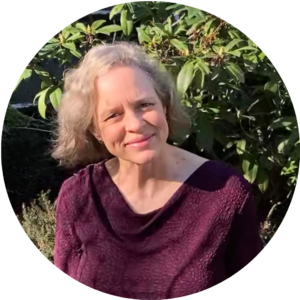
After a decade of working as an ultrasound technologist in breast imaging, and educating women on their own breast health, Carolyn unexpectedly found herself in her patients’ shoes.
Born and raised in Victoria, Carolyn has also lived in Calgary and Saudi Arabia. She returned to Victoria in 1996 when she took a position as an ultrasound tech, and worked in Island Health for 25 years before retiring three weeks ago.
Carolyn worked the last 15 years of her career in nuclear medicine, as well as breast imaging at Victoria General Hospital (VGH)—Vancouver Island’s referral centre for women’s health and mammography.
“You need to have a certain demeanour, because a lot of these patients are coming in with some anxiety and fear of the unknown,” she says.
Five years ago, Carolyn noticed dimpling—an abnormality—on one of her breasts. Though she’d always made sure to have regular mammograms, she knew having dense breasts meant that some cancers might not show up on a mammogram.
“Women have different breast densities. If you have fatty breasts, we can see changes or abnormalities very easily,” says Carolyn. “But if you have dense breasts, the tissue fibres can overlap and hide things, and we really need to have the proper imaging available in order to sort it out.”
Sometimes, an ultrasound is needed in addition to a mammogram. After an ultrasound revealed an abnormality, Dr. Brent Lee, a radiologist and the Medical Leader of Breast Imaging for Island Health, performed a biopsy (also under the guidance of ultrasound), which confirmed Carolyn’s suspicion.
“In my case, my cancer was hidden because of my breast density,” she says.
Carolyn also had an MRI to give her physicians a more accurate look at what was happening inside. With this information, Dr. Alison Ross then performed a lumpectomy—also known as a partial mastectomy—at VGH to remove the cancer, as well as a sentinel lymph node biopsy (SLNB), in which a lymph node is taken from the armpit to determine the stage of the cancer. Prior to the surgery, an ultrasound machine was used to insert a guide wire to help locate the cancer. Carolyn was able to return home the same day.
“The care was wonderful all along the way,” says Carolyn. “And if we hadn’t caught this, it would have been life-threatening.”
Carolyn then underwent radiation therapy, and was able to return to her position as an ultrasound tech in breast imaging two months later.
“My knowledge helped me with my perspective. Waiting for the biopsy results was difficult, as well as the unknowns of what the next steps would be,” says Carolyn. “But I knew not to panic because the outcome can be just fine once you go through the treatment.”
Now, she’s passionate about educating other women about their breast health.
“If you catch things early, then the outcome is very good. It’s the ones that aren’t caught earlier that have more difficult outcomes,” says Carolyn. “I’ve always tried to educate people to make a point to know themselves, to know when something is normal or when it isn’t—and to know their own breast density.”
She says that women sometimes put off their mammograms and don’t realize that years have passed since their last one.
“Don’t put off your mammogram. Women tend to take care of everybody else and put themselves last,” says Carolyn. “They don’t make time for themselves.”
She says that the proper equipment is key to diagnosing and treating breast cancer in a timely manner, and that all of the equipment—such as ultrasound and mammography machines, and MRIs—works together. In a complex field that affects so many women, every piece of equipment plays a vital role in someone’s care journey.
Through Emerge Stronger, the community can help fund several pieces of equipment for Victoria General Hospital to help ensure radiologists like Dr. Lee and ultrasound techs like Carolyn have the proper imaging tools they need to provide the best care for their Vancouver Island patients. The new equipment includes a $31,000 high-resolution mammography monitor, an $87,000 ultrasound machine, and $99,000 Breast-Imaging CAD (computer-aided detection) Software, which allows radiologists to use MRI scans to diagnose small and early-stage breast cancers.
“The imaging is getting better all the time with better equipment,” says Carolyn. “And it becomes easier to diagnose people sooner.”
Carolyn says that gifts made to support our hospitals end up circling back to them. “A gift benefits you when it’s your turn to need care, as well as your loved ones and the general public.”




